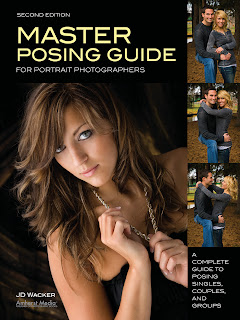
Today's post is an excerpt from the book Master Posing Guide for Portrait Photographers, 2nd Ed. by JD Wacker. It is available from Amazon.com and other fine retailers.
PSYCHOLOGY
Love Is in the Air. More than any other type of portraiture, wedding portraits should capture the love between the bride and the groom and from their family and friends. Certainly, recording images of groups and events on the big day is essential. But it shouldn’t overshadow the opportunity for you to create images that show love. Everyone is dressed in their best clothing, happy (well, usually), and having fun. Make the most of it. Be creative and be prepared to capture special moments that just happen and are nearly impossible to re-create.
Mutual Respect. Conduct yourself as a professional and let your subjects know they are important to you. Let them know that you want to create fantastic images that they will treasure forever, but don’t want to interfere with their wedding day. Have a plan and let them know what it is. They will respect you and be
more cooperative. It will be a win–win situation.
Keep Your Cool. Wedding Photographer Horror Stories could be the next best-selling thriller or reality show. Expect anything to happen and be ready to adapt. Make it clear that you are trying to do your best for them, but don’t argue or be agitated. Many of the people involved have a lot time invested and little sleep. So, be understanding. Also, be aware that many of the attendants won’t know what’s going on and may see you in a bad light.
Be creative, have fun, and be ready to capture images that reflect the unique character of the bride and groom.
MECHANICS
The Bride. Pose the bride as you normally would pose a woman, and make the dress and accessories work to your benefit, not against you. Accentuate the long, flowing, graceful lines of the veil and train. Define the waistline by separating the arms and the body and by twisting the body at the waist. If the bride is holding a bouquet, position it in the hand farthest from your main light source and slightly above waist level for three-quarter and full-length portraits. With the other hand, try more formal, dance-like poses of the bride’s hands by bending the hand away from the body at the wrist, showing the edge of the hand, and elongating the fingers. Turn the bride away from the main light source to maximize dress detail.
The Groom. Again, it is the unique clothing that will provide new posing opportunities. Suits and tuxedos are more restrictive to movement, but encourage straighter posture that invokes a feeling of positive attitude. Use this attitude to your advantage. You’ll capture more dynamic images of the man, simply because he is more excited and more sure of himself as a subject.
The Bride and Groom. As opposed to most portrait sessions where you must build up the energy level, at a wedding all you need to do is be ready for it to happen. You can guide the couple into poses that encourage their natural interaction. As with any couple, the combination of the bride in a graceful S-pose and the groom in the strong C-pose will add artistic value to the portrait. Just have them look at each other and hold each other, or have the bride look at her ring or flowers and have the groom look at her. At these points, their expressions will be genuine and full of love. If you get them involved with their parents, the wedding party, and the guests, special moments will arise for you to record in wonderful portraits.
Guide the couple into natural poses than encourage interaction.
The Wedding Party and Families. The number of people involved at a wedding can be astronomical. You can’t expect all of them to feel well and be excited about having their portrait taken. Work quickly and efficiently, but still pay attention to detail. An assistant can be very helpful when posing groups. One of you can handle the camera and lighting while the other arranges the individuals and helps them pose. Order of importance and height are two major factors when arranging groups at a wedding. Place the most important individuals closest to the bride and/or groom. Sort individuals and couples by height to ensure that everyone is seen and has his own space and that the group is balanced as a whole. The bride and groom are obvious centers of interest and can serve as the focal point in a more interactive style of portrait.


Whrranging group shots, place the most important individuals closest to the bride and groom.
Buy this book from Amazon.com.




